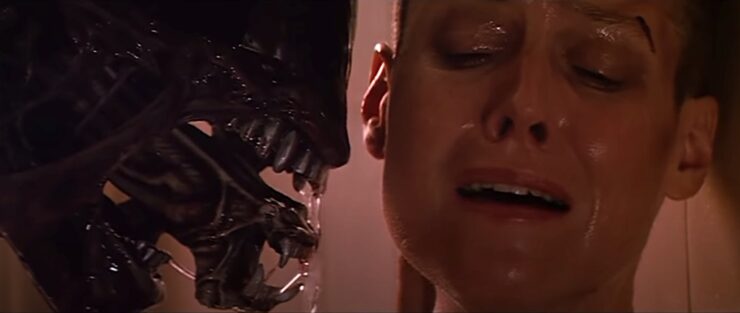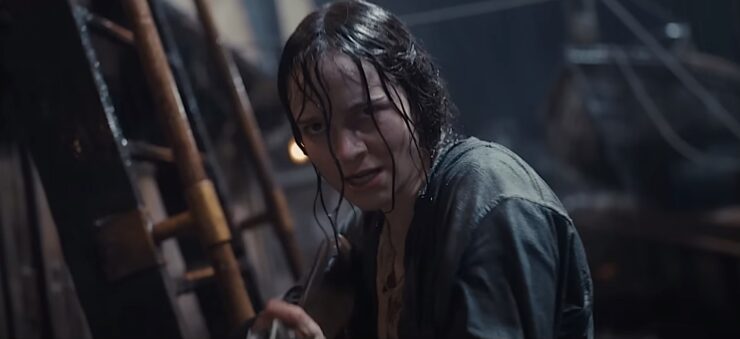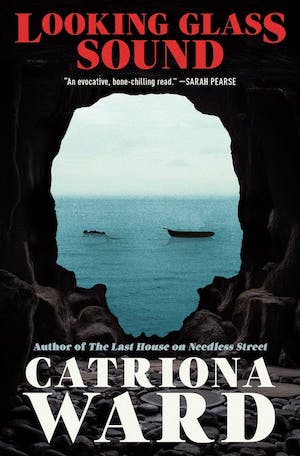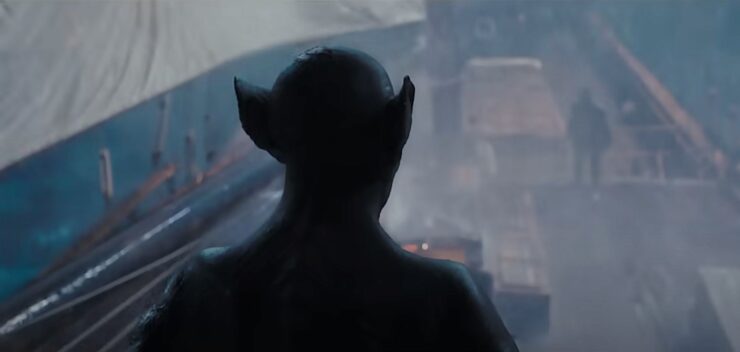It’s a common joke amongst the Extremely Online that The Last Voyage of the Demeter could be summed up by the pitch “Dracula, but on a boat and it’s really just Alien.” Even director André Øvredal, in a Q&A with Bloody Disgusting, cited the original 1979 Alien as a major influence on Last Voyage.
The comparison isn’t wholly unearned, but it doesn’t fully capture the tone or the mood of the movie. The Last Voyage of the Demeter is less like “high seas vampire Alien” and much more like “high seas vampire Alien 3.”
The Last Voyage of the Demeter adapts a single chapter from Bram Stoker’s 1897 novel Dracula, in which the titular monster makes his way from the Carpathian Mountains to London, by sea. Because Dracula is an epistolary novel, this chapter is composed of log entries from the doomed ship Demeter, recounting the demise of her unnamed crew as they are picked off, one by one, by a stowaway vampire. Most film adaptations of Dracula skip over this portion of the story and choose instead to focus on the novel’s named characters as their lives are entangled in Count Dracula’s decision to find new hunting grounds in England. Stoker’s novel harbors a classist streak atop its more overt xenophobia, presenting any characters not of “respectable” birth as being unfortunate at best and barbaric at worst. The characters of the Demeter log are nameless victims in a ruthlessly efficient chapter that is never again brought up after its conclusion. No one on board the ship survives, but then again, in the novel’s eyes, none of them matter as much as the other point-of-view characters. The crew of the Demeter might as well be long-haul truckers on the high seas, a mere vehicle to get Dracula from one place on the map to another.
The connection between Last Voyage and Alien is a relatively intuitive one: both films are about blue-collar workers transporting precious cargo that will lead to their demise. Alien makes space truckers just as interesting as the elite astronauts of previous sci-fi films; Last Voyage does the work to draw parallels between the crew of the Demeter and the crew of the Nostromo. As in Alien, Last Voyage features a discussion of profit-sharing around a dinner table near the beginning of the film that establishes the class standing of everyone on board. Both the Nostromo and the Demeter house a ship’s pet that serves as a beacon for danger for the rest of the crew: on the Nostromo, it’s Jones the cat, while on board the Demeter, it’s a dog. Last Voyage even dares, early on, to quote an iconic shot from Alien in which a character enters the ship’s hold, framed by a massive door that reveals a cavernous space stacked with boxes, clanking chains festooned from the ceiling.
Both the Nostromo and Demeter crews find themselves isolated, afraid, and alone in the deeps, fighting for their survival against a monster they can’t hope to understand that keeps picking them off one by one. However intentional these similarities, the Alien touchstones in Last Voyage are surface-level signals of the genre the movie is working in, and nothing more. They’re obvious, but they distract from the fact that Last Voyage is spiritually much closer to Alien’s erstwhile sequel Alien 3.

Alien 3 has been reclaimed critically in recent years, but it’s still polarizing, a grim reiteration of the nihilism of the first Alien, without any of the heart or adrenaline of Aliens. David Fincher has disowned the movie, even though it was his directorial debut. The production was troubled, and the story is dark (even by Alien standards) as it follows the standard formula of a xenomorph picking off a small group of people one by one. Its cast comprises a colony of men on a prison planet who might as well remain nameless. When Ripley (Sigourney Weaver) crash-lands on their planet, xenomorph in tow, the prisoners are wary of her presence, afraid of the “temptation” someone of her gender presents to them. The prisoners might be death-row inmates, but they’re also penitential religious fanatics who have chosen to serve out the rest of their sentences far removed from society. Despite their mistrust of her, Ripley manages to rally the men against the xenomorph, and in so doing, she rekindles a spark of humanity that the prisoners had forgotten about themselves long ago. Alien 3 is a movie about the horrors of being stuck in a society that does not value individual human lives in general, and that relegates women in particular to the sidelines as a sort of monstrous “other.”
It’s the sense of isolation and suspicion about an “othered” gender—and stubborn hope from people of that gender against bad odds—that makes Last Voyage more of a spiritual successor to Alien 3 than to Alien. Both films feature a small crew of characters who aren’t particularly distinct from each other. Both start bleak and end bleaker, with most of the cast dead long before the film is over. Both include a funeral scene for a child in which a prayer is spoken over the body claiming that the child is in a better place now, where they’ll no longer feel hunger or pain. Both funeral scenes end with the child’s soul being committed “to the deep,” and with the body falling from a height and being engulfed in flames. The audience is supposed to be deeply affected by the death of a child in both movies, but Alien 3 and Last Voyage treat those deaths as clinical, almost perfunctory. It’s an artistic choice that works if you’re plugged into the movie’s general affect, but if the rest of the movie doesn’t work for you, then this plot point feels callous and detached.
It’s worth noting that Last Voyage is set on a wooden sailing ship that’s increasingly detached from reality, not just because it’s out to sea, but also because it’s on the edge of becoming a relic, captained by a man who’s ready to leave his voyages behind to finally retire. One of the early scripts for Alien 3 was set on a planet made entirely of wood and populated by Luddite monks; while the all-wood planet was abandoned after David Fincher took over, the low-tech attitude of the script remained. The prisoners of Alien 3 are armed with torches and “harsh language,” as one of them puts it. Likewise, the crew of the Demeter scarcely stands a chance against a bestial Dracula, armed as they are with simple knives, muskets, and their suspicions about their own female stowaway.

Last Voyage circles around an original character named Anna (Aisling Franciosi), a woman who has lived under the shadow of Castle Dracula her entire life. When she’s discovered in one of the boxes on board, the crew treat her with the same suspicion that the prisoners of Alien 3 treat Ripley with. One sailor repeats that it’s “bad luck to have a woman on board,” and Anna, like Ripley, is reticent to talk about her connection with the monster stalking the crew. Anna and Ripley both know that no one else will believe their stories, and they’re keenly aware of their vulnerability due to the prejudices the men around them carry towards their gender. Neither woman is treated fully like a human being; they’re both considered a threat above anything else by the men around them. Ripley and Anna each have a single ally in their situation: a doctor who cares for them when they’re first discovered, injured and weak. Conveniently, the doctor in Last Voyage (Corey Hawkins) and the doctor in Alien 3 (Charles Dance) are both named “Mr. Clemans.”
Buy the Book


Looking Glass Sound
Anna’s character arc in Last Voyage closely mirrors Ripley’s in Alien 3. Anna is connected to Dracula; she can sense his presence, and he can see through her eyes. He won’t kill her, because she’s a useful pawn, and eventually she’ll turn into a vampire like him. Likewise, the xenomorph in Alien 3 won’t kill Ripley, because she’s carrying an alien queen inside her chest. Both women are inextricably connected to their respective monsters in a way that they know will kill them. Both choose to fight back anyway, helping the crew on the Demeter and the men on the prison planet, even though both tasks are thankless and hopeless. Ripley falls into a tank of molten lead to prevent Weyland-Yutani from getting a hold of her alien. Anna intentionally exposes herself to sunlight, bursting into flames as a result of her gradual turn towards vampirism. Both women choose how they go out, immolating themselves so that they won’t be a conduit for more evil. Anna refuses to become a vampire; Ripley won’t become the mother of a monster. Neither of them owes the world that shunted them to the sidelines anything, and yet they’ll still each sacrifice everything in order to keep the innocent safe from ravenous monsters.
The Last Voyage of the Demeter takes a stab at trying to explain why the characters in a neglected chapter of Dracula also matter. Alien 3 attempts the same, to slightly greater effect. Neither movie fully succeeds, but if you’re tapped into the general vibe of Alien 3, Last Voyage might just work for you for similar reasons.
Sarah Welch-Larson is interested in feminist theory and theology, sad men in space, and stories about agency and creation, especially when they include cyborgs or androids. She is the co-host of the Seeing & Believing podcast, a staff writer at Bright Wall/Dark Room, and the author of the book Becoming Alien: The Beginning and End of Evil in Science Fiction’s Most Idiosyncratic Franchise. She lives in Chicago with her husband, their dog, and about three dozen houseplants.










